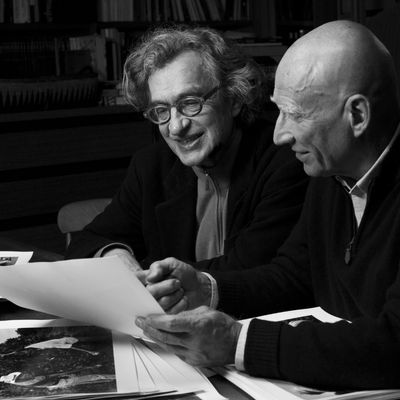
When I was a kid in the 1980s, Wim Wenders and Sebastiao Salgado were two of the biggest Capital-A Artists in the world: Wenders, the German director who made stoic road movies full of existential longing and wide-open spaces, and whose films were issued in black VHS editions with a huge ÔÇ£WENDERSÔÇØ on the cover; Salgado, the Brazilian photographer who took images of suffering and labor and war and ruin and turned them into something sensuous and unreal, whose reproductions populated every middlebrow poster store. They had achieved what serious artists simultaneously dread and fantasize about: They had become┬ábrands. But there was a very real achievement beneath the commodification, too. WendersÔÇÖs cinematic despair was no less sincere for being fashionable, and SalgadoÔÇÖs willingness to go to the most treacherous places and work under the most intense conditions to get his shots came from a place of genuine artistic inquiry and human anger.
That becomes clear in The Salt of the Earth, a documentary about Salgado made by Wenders and Juliano Ribeiro Salgado, the photographerÔÇÖs son. ItÔÇÖs a fascinating meeting of three minds, and perspectives. Chief among them is Salgado himself, narrating the story of his life, of how he fled the Brazilian dictatorship and then abandoned a promising career as an economist to pursue a crazy artistic passion. He would traverse the world, using his hauntingly expressive photographs to expose the harsh existence of his fellow humans. Meanwhile, we hear Juliano, the son, ruminating on a father who was often absent, and Wenders, the admiring outsider, brought in by the younger Salgado to collaborate on this bizarre project. Given this fractured-three-ways perspective, itÔÇÖs surprising how smoothly The Salt of the Earth moves, how gracefully it switches back and forth between the personal and the objective.
The film is steeped in melancholy. Salgado has had success, fame, and money, but he has also spent much of his life among refugees, war victims, and slaves, and he seems to suffer from something resembling post-traumatic stress. Retiring to his family farm, itself devastated by drought, he tries to repair the landscape around it ÔÇö an attempt, perhaps, to achieve some kind of tangible healing in a world whose wounds he spent so many years portraying.
What about the contention by some critics that Salgado overtly aestheticized human misery? The film doesnÔÇÖt directly address that, but it probably doesnÔÇÖt feel it needs to. The whole point of the movie is that Salgado wanted to reveal the suffering of his fellow man. The fact that he found beauty there, at least in this filmÔÇÖs view, speaks not to callousness or opportunism but an honest belief that beautiful art can cross borders and win hearts and minds. The beauty draws you, while the tragedy compels you. And SalgadoÔÇÖs journey also speaks to something more in keeping with WendersÔÇÖs work. Here is a man trying to punch away, in his own way, at the indifference of the world. ThatÔÇÖs not so different from the directorÔÇÖs earlier road movies.
But perhaps the most impressive thing about The Salt of the Earth is its ability to revel in the work itself. In his documentaries, Wenders has tended to focus on other creative figures. When I interviewed him recently, he said that he thinks the creative process is ÔÇ£the last great adventure left on our planet.ÔÇØ And, as he did with Pina and with The Buena Vista Social Club, heÔÇÖs more than happy to cede the screen to the artist at hand: The Salt of the Earth is replete with SalgadoÔÇÖs photography, and the images, seen in succession on a screen, have a mesmerizing effect. Watching Salgado work ÔÇö giving up on a shoot because he couldnÔÇÖt find the right background, for example ÔÇö you realize the thinking and planning that goes behind the shot. A thing of beauty can also be a mechanism, a network of verticals and horizontals and backgrounds and foregrounds. The result may be ineffable, but itÔÇÖs still constructed from something by somebody. ┬áThe Salt of the Earth lays bare the artifice, even as it lets the mystery be.


